Seagate: Hard Disk Drives Set to Stay Relevant for 20 Years
by Anton Shilov on December 18, 2015 10:00 AM EST
The very first hard disk drives (HDDs) were demonstrated by IBM back in 1956 and by the early 1980s they became the dominant storage technology for all types of computers. Some say, hard drives are no longer relevant as solid-state drives offer higher performance. According to Seagate Technology, HDDs will remain in the market for at least 15 to 20 years. In a bid to remain the primary bulk storage device for both clients and servers, hard drives will adopt a multitude of technologies in the coming decade.
“I believe HDDs will be along around for at least 15 years to 20 years,” said David Morton, chief financial officer of Seagate, at the Nasdaq 33rd Investor Program Conference.
Sales of HDDs Decrease, But Technology Keeps Evolving
Sales of hard disk drives have been decreasing for several years now. Total available market of HDDs dropped to 118 million units in the third quarter of 2015, according to estimates by Seagate Technology and Western Digital Corp. By contrast, various makers of hard drives sold approximately 164 million units in Q3 2010, the two leading manufacturers claim.
Shipments of HDDs decrease due to a variety of factors nowadays, including growing popularity of solid-state drives (SSDs), drop of PC sales, increasing usage of cloud storage and so on. Nonetheless, HDDs remain the most popular data storage technology, which is also the cheapest in terms of per-gigabyte costs. While SSDs are generally getting more affordable, high-capacity solid-state drives are not going to become as inexpensive as hard drives any time soon. As a result, HDDs will remain a key bulk storage technology for a long time.
To stay relevant in the long term, hard disk drives need to keep increasing their capacity. Last year ASTC (Advanced Storage Technology Consortium), an international organization that unites various companies who develop, manufacture or use hard disk drives, unveiled its vision of the HDD future. According to this technology roadmap, capacity of hard drives will rise to 100TB by 2025. In the coming years HDDs will adopt many new writing technologies in a bid to bolster their data storage capacities.
PMR, SMR and Helium
Modern hard disk drives are based on perpendicular magnetic recording (PMR) and shingled magnetic recording (SMR) technologies. PMR-based drives have been around for about a decade and will remain popular for years to come thanks to their relatively high sequential performance, low cost per gigabyte, and well-understood reliability.
HDDs that use shingled recording write new tracks that overlap part of the previously written magnetic tracks. The overlapping tracks may slowdown writing because the architecture requires HDDs to rewrite adjacent tracks after any writing operation. While SMR allows increasing areal density of hard drives to 1.1 Tbit per square inch or even higher, performance of such HDDs may be lower compared to performance of PMR-based devices. In a bid to “conceal” peculiarities of SMR, which can slowdown performance, makers of HDDs develop special firmware or even alter software applications that use such hard drives in datacenters.
To boost capacities of PMR and SMR hard disk drives today without increasing areal densities, HDD makers need to install more platters into their devices. While it is possible to fit six disks into a standard 3.5” HDD thanks to new technologies, more platters require major redesigns and use of helium inside the drives. The density of helium is one-seventh that of air, which reduces drag force acting on the spinning disk stack and lowers fluid flow forces affecting the platters and the heads. The lower density of helium allows to fit up to seven disks into one drive today, reduce power consumption of HDD motors and improve accuracy of arm’s positioning, something that is important for high bit densities too. Unfortunately, hermetically sealed helium-filled HDDs are rather expensive to manufacture, which is why at present they are positioned for datacenters.
At present only HGST, a wholly-owned subsidiary of Western Digital, ships helium-filled Ultrastar He and Ultrastar Ha hard disk drives in high volume. The company sold around 1.1 million sealed HDDs in Q3 2015 and demand for such drives is increasing. Seagate Technology plans to introduce its helium-filled HDDs in the first half of 2016.
TDMR Incoming
Earlier this year Seagate announced plans to start commercial shipments of hard disk drives featuring two dimensional magnetic recording (TDMR) technology in the next couple of years. Heat-assisted magnetic recording technology (HAMR) — that has been demonstrated for multiple times so far by various manufacturers of hard drives, heads and platters — is still not ready for prime time, according to Seagate. The world’s second largest maker of HDDs claims that reliability of devices based on HAMR is not sufficient, which is why the tech will be used commercially at a later date.
“We talked last year about two dimensional magnetic recording, we will be ready to ship that in the next year or two,” said Dave Mosley, president of operations and technology at Seagate, at the company’s analyst and investor strategic update conference in September. “HAMR is still not ready for prime time, I was not tremendously happy with the progress made last year, but there was a progress.”
TDMR technology allows to increase areal density of hard disk drives by making HDD tracks narrower and pitches even smaller than today. Since tracks are projected to become narrower than actual magnetic read heads, it will get increasingly hard for the latter to perform read operations because nearby tracks will create too much inter-track interference (ITI). HDDs featuring TDMR technology counteract ITI by reading data from multiple nearby tracks and then determining which data is needed. The industry is working on several implementations of TDMR. It is possible to read data from multiple adjacent tracks using one reading head, but that greatly reduces performance of HDDs. Alternatively, it possible to use an array of heads to read data from several nearby tracks. While such approach guarantees rather high performance, it is very hard to build a complex array of multiple readers. TDMR lets HDD makers to increase areal density by 5 to 10 per cent, according to Seagate. Moreover, it also solves ITI problems that will likely occur in the future. As a result, it is logical to expect all HDD makers to use two dimensional magnetic recording technology in the future.
HAMR Not Ready for Prime Time
Hard drives featuring heat-assisted magnetic recording technology — as the name implies — record data on high-stability magnetic media with laser thermal assistance to reduce its coercivity for a very short amount of time. Seagate’s HAMR technology heats media to approximately 450°C using a laser with 810nm wavelength and 20mW power, according to details revealed by the company earlier this year. The method helps to reduce size of magnetic “pitches” without undesirable effects on readability, write ability and reliability.
Hard drives with HAMR technology will sport significantly higher areal densities — around 1.5Tbit per square inch initially and 2Tbit per square inch shortly after introduction — and will be able to store noticeably more data than today’s HDDs featuring perpendicular recording technology. Eventually, companies like Seagate expect that HAMR will help to increase bit densities of hard disk drives to 5Tbit per square inch. While TDMR technology is important, HAMR will mean a breakthrough for areal densities and capacities of HDDs.
“The highest areal density that we see today have to be written with HAMR,” said Mr. Mosley. “We still have some issues working through the reliability. We have actually solved a lot of problems, but the whole industry — through various consortiums — is really focused on getting the last of the problems solved so we could get [HAMR] into the products.”
Seagate hopes to deliver its first HAMR-powered hard disk drives with 4TB capacity sometimes in late 2016 or early 2017 to select clients. The customers are expected to tryout the HDDs in their datacenters, verify that HAMR drives are compatible with their infrastructure, and are generally reliable. Volume shipments of HAMR-based HDDs are now expected to start in late 2017, or even in 2018. Unfortunately, at this point the HAMR roadmap is not completely clear.
Long Road Ahead
In addition to two dimensional magnetic recording and heat-assisted magnetic recording technologies — that Seagate expects in commercial products in 2016 – 2017 and beyond — other technologies are being researched by the industry. Among those already disclosed are Bit Patterned Media Recording (BPMR), Heated Dot Magnetic Recording (HDMR), Microwave-Assisted Magnetic Recording (MAMR) and some other. In the future, hard disk drives will adopt combinations of various technologies to maximize bit densities and capacities.
Technologies like TDMR, HAMR or BPMR will be commercialized by manufacturers like Seagate, Western Digital and Toshiba. However, there are many companies and universities, who explore technologies for future hard disk drives. For example, reliability of HAMR-based HDDs is something addressed by the whole industry, not just by Seagate or Western Digital. Such collaborative approach and with continuing investments into fundamental magnetic recording research increases the likelihood of many technological breakthroughs going forward. The latter may guarantee that HDDs will remain relevant for a long time — for at least 15 to 20 years, according to Seagate.
If HDDs remain in the market in 2035, it will mean that the technology will have served the humankind for about 80 years at the time, which is a very long period for any high-tech industry. By the time, HDDs will have outlived floppy discs, cassettes, CRT displays and televisions as well as numerous manufacturers of hard drives.


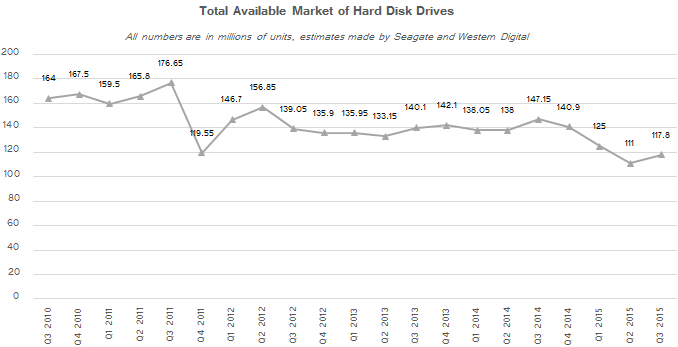
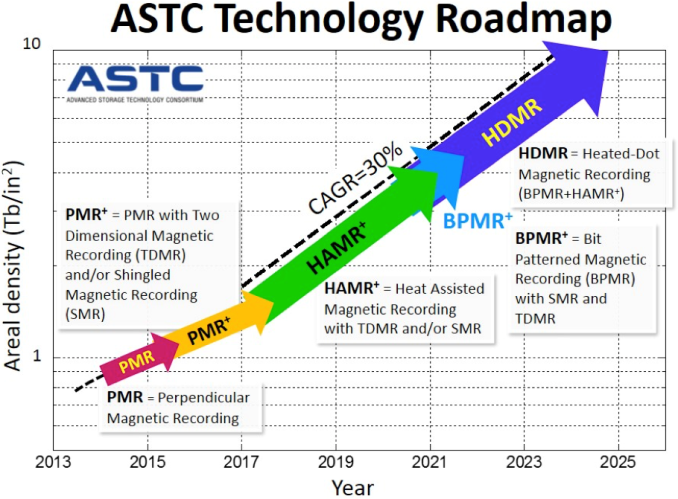
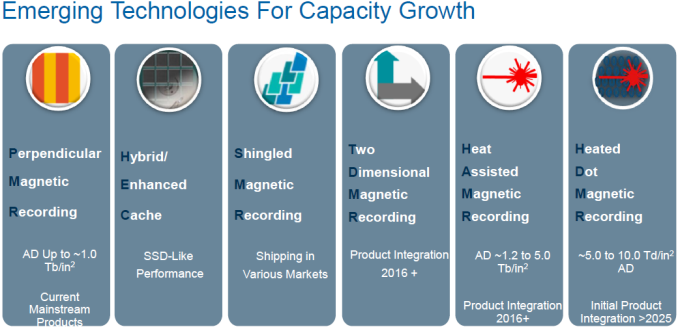
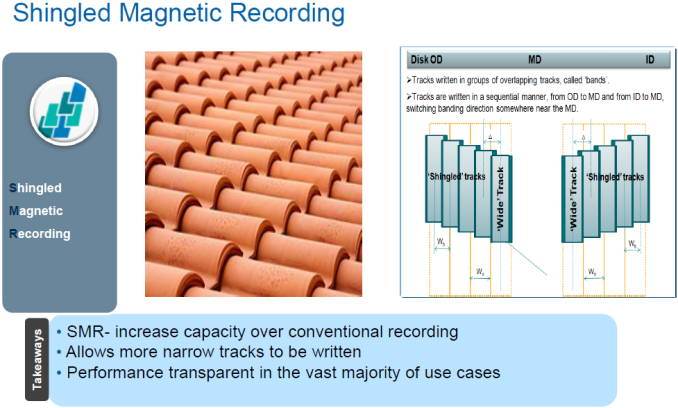
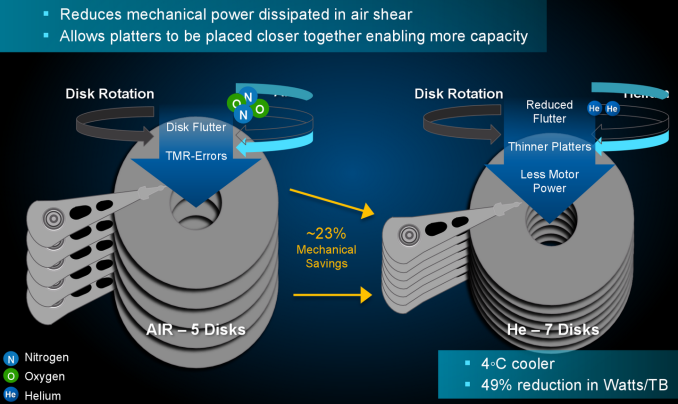
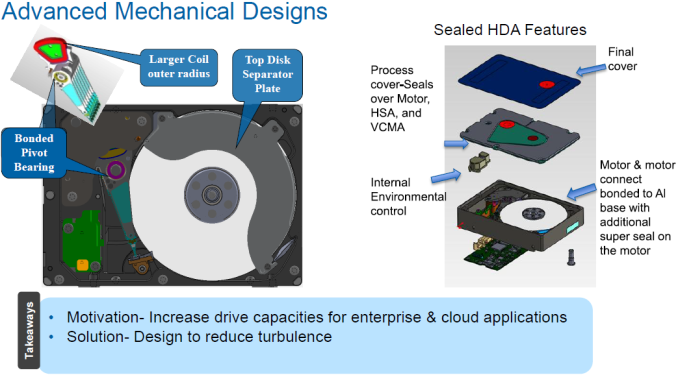
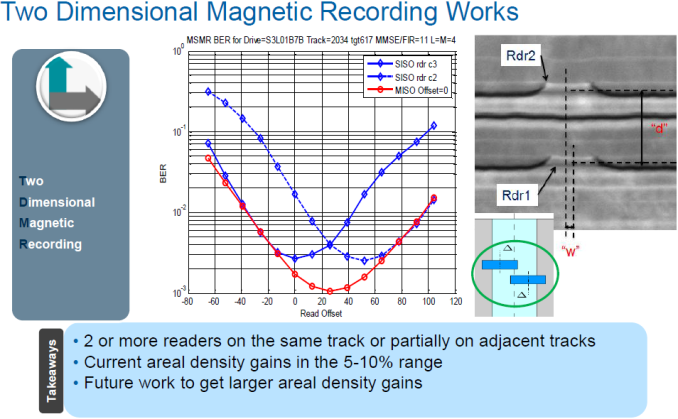
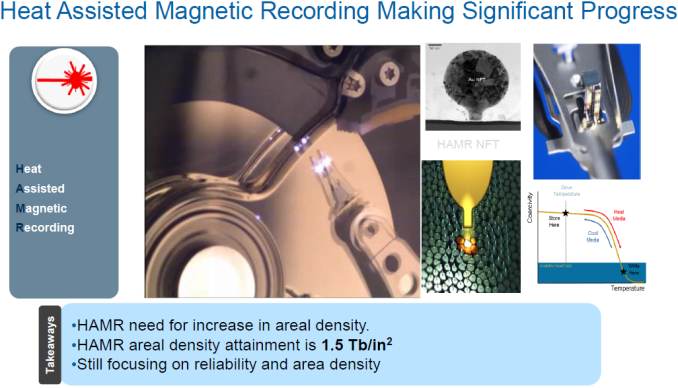
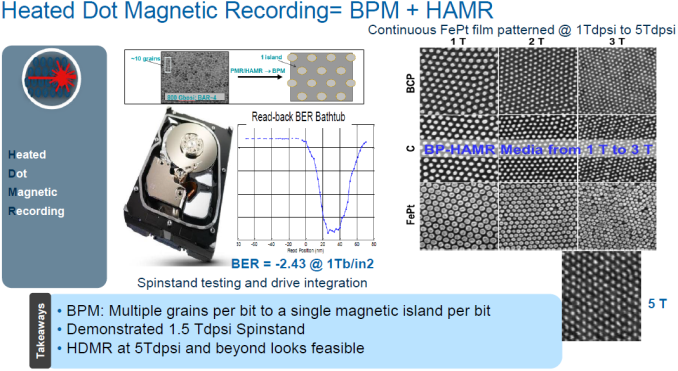








86 Comments
View All Comments
phoenix_rizzen - Friday, December 18, 2015 - link
I want a 3.5" SSD. Why limit SSDs to the 2.5" form-factor?extide - Friday, December 18, 2015 - link
Because of price. Samsung can already fit 4TB of NAND in a 2.5" drive and it will probably cost ~$1500 based on the fact that the 2TB one costs >$800 -- so by making a bigger ssd to fit more flash -- its going to cost several thousand dollars. Who would buy that? Too few people at the moment.Now in the enterprise world you already see this -- although it is on PCIe cards instead of 3.5" form-factor SSD's. You can buy PCIe cards with 3-4+TB of space, for several thousand dollars and that's a thing in that market, but just wouldn't work for consumer.
atcronin - Friday, December 18, 2015 - link
I look forward to scrubbing/resilvering a pool containing 50TB drives with 150MB/s read speeds.extide - Friday, December 18, 2015 - link
They would have SIGNIFICANTLY higher read/write speeds .. in sequential. The 10TB HE drives are already pushing 240-250MB a sec. As the density goes up the sequential speed naturally goes up too as more data is flying past the head per unit time. a 50TB drive should easily be able to do 1-2GB a sec sequentially.stevenrix - Friday, December 18, 2015 - link
Since the flood of Thailand i noticed the following:- Hard-drive prices took a hike of 300%. I remember buying top of the line hard-drive of 2Tb back then in 2011 for merely $60. Today's price is $180 for the very same drive.
- The consumer market is still stuck around 4TB hard-drive size, consumers do not want to shift to higher capacities because the price is too high, it starts doubling for 6 Tb.
- Hard-drive prices will continue to be expensive because they have to maintain 2 technologies and despite their shipment they never recovered cheaper prices.
- I would wait next year with a sharp decline in hard-drive prices because the global demand will slow down
TekBoi - Friday, December 18, 2015 - link
Exactly this.Magichands8 - Friday, December 18, 2015 - link
I can see HDD lasting for some time down the road for mass data center storage and maybe low end budget systems but I would very surprised if HDDs survived for the next 20 years in the consumer space. Any consumers with interest in these super high capacity HDDs is going to be aware of the drawbacks and nobody like that is going to want to store so much data on a single point of failure device with such low performance. What's that? Just use RAID, you say? Sure, then when you get a couple of drive failures you can spend the next six month rebuilding your array of dozens of terabytes of data at 80MB per second. Have fun with that. RAID makes sense for mass scale storage deployments where a company has the time and resources to deal with live rebuilds for enterprise applications but not for consumers. As an end user it's frequently a tremendous frustration for me that my super fast SSD is brought to its knees while waiting for media transfers to and from my HDD at 80-120MB/s. A system can only be as fast as its slowest component.As for 3D Xpoint, it's a 3D stackable technology, so according to Intel it's not going to be that difficult to ramp up capacity. The technology is already in production and Intel has stated that devices for consumers will be available in 2016. Personally, I'm waiting to see what happens in 2016 with this technology before upgrading or any new drives.
Another point I've not seen addressed here is that a lot of these spiffy new technologies being developed to stretch HDD capacities are going to increase the cost of the drives. They are improving capacities and increasing production costs while retaining all of the weaknesses of current HDD technology.
stephenbrooks - Friday, December 18, 2015 - link
How about crinkle-cut platters so they have more surface area?I think one way or another the long-term future of storage is going to be 3D, either by stacking NAND, or holographic. It's a shame they don't know how to rewrite magnetic domains in the interior of the platter (depthwise).
iwod - Friday, December 18, 2015 - link
I dont think any consumers, or even geek cares about the HDD capacity anymore. The Consumer HDD drive business, much like the PC market is shrinking. But similar to Intel's case the growing appetite in Cloud Business has increased more then enough to cover the the loses.HDD will continue to thrive as long as we continue to create huge amount of Data. NAND, even with TSV is not going to take over HDD in the next 10 years. I am not sure about 20. But definitely not 10. Some people will go about saying Micro SD went from 128MB to 128GB in 10 years, but that is forgetting NAND went from using many node generation behind leading node to now basically they are the leading node to test. The headroom in 2003 were huge, and MLC were being tested as well as TLC. Today we have TSV that could stack to unknown number of layers. I remember reading an engineers saying there are nothing stopping them to do 1024 layers, they dont know what sort of problem they would face when it is that many layers.
But even at TSV 1024 layers, the cost per TB still doesn't rival HDD. Not to mention the power / TB also flavors HDD.
So definitely not in 10 years. 20years? I dont know since that really is too far fetched, but the 10 year roadmap for both technology has pretty much set in stone.
Some will also say the price for Cloud Storage will drop to very very low, an leading example would be Blackbaze B2. However, the cost of GB % has shrinking to the point where it is now largely dominated by Bandwidth cost and Power cost. And both cost has not even shrink in MANY years.
It is a bit like Amazon AWS continue to give you more Memory and CPU resources, but your port speed and bandwidth transfer stays the same.
Arbie - Friday, December 18, 2015 - link
How does increased use of the cloud decrease the amount of HDD space needed? Does the cloud just have a really good memory and not need to write stuff down?